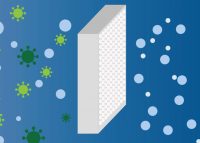Fighting climate change just got a lot harder. Thanks to COVID-19, reducing carbon emissions from buildings is even more of a challenge now as properties are increasing ventilation, upgrading air filtration, and running their systems for longer time frames in order to keep occupants safe and comply with recommendations from the American Society of Heating, Refrigerating and Air-Conditioning Engineers (ASHRAE). These recommendations are used by much of the facilities management industry and have a huge impact on the country’s energy usage. As it stands, the global real estate industry is the number one contributor of greenhouse gas emissions, more so than any other sector of the economy, including transportation. Real estate also “accounts for 40 percent of the world’s energy consumption” and “uses 40 percent of the world’s raw materials.” It’s hard to imagine those numbers getting worse, but that’s exactly what’s beginning to happen.
ASHRAE’s recommendation for increased ventilation requires more outside air to be brought indoors to flush out and dilute possible contaminants. When the outside air temperature is much colder or hotter than what humans typically consider comfortable, this process inevitably requires more energy. In addition to increased ventilation, building operators are running their systems for longer hours after occupancy in order to perform daily purges—often up to two times a day. Similarly, air filters that can remove smaller particles are denser and require HVAC systems to expend more energy to push air through them.
One of the organizations helping the property industry navigate the tradeoff between ventilation best practices and climate goals is NYSERDA, the New York State Energy Research and Development Authority. They promote and incentivize energy efficiency and the use of renewable energy sources as a way to help the State of New York meet is aggressive energy goals. Patrick O’Shei is the Director of Market Development at NYSERDA. He recently spoke with Propmodo about NYSERDA’s partnership with ASHRAE to help determine the safest and most energy efficient way forward. The goal of the partnership, according to O’Shei is decarbonization, but more specifically, “In terms of COVID recovery, we would like to have specific guidance for buildings in New York state that allow us to safely operate with the highest level of energy efficiency and the lowest carbon footprint.”
Retail HVAC requirements
Exactly what that guidance looks like hasn’t been fleshed out yet. Similarly, at the end of June, Governor Cuomo announced that malls in New York state would be unable to reopen unless “they have air filtration systems that can filter out the COVID virus,” but aside from mentioning the use of HEPA filters or increasing the filter’s MERV rating, no other guidance is provided mainly because each individual building will have different specifications to meet these goals. In the same announcement, the NY governor also said that the state was recommending that all businesses and offices ‘explore the potential for their air conditioning air filtration system.’” This announcement came just after the country witnessed a spike in COVID-19 cases in the south where hot temperatures typically require more people to be indoors with their air conditioning on earlier in the summer season.
Since the end of June, COVID-19 cases in southern states like Florida, Louisiana, Mississippi, and Alabama have seen daily new cases continue to multiply, with Florida setting the record for the most new cases in one day (15,299 on July 12). Now, the state is averaging 10,585 cases per day, which is sixteen percent higher than the previous two weeks. I provide these statistics to emphasize the dire reality of the situation. While a lot of factors go into the spread of the virus, HVAC systems play an important role, especially in commercial properties. O’Shei told us, “There are differences between hospitals and commercial buildings. Hospitals have bigger equipment, use more fresh air, and operate their systems 24/7. Commercial building owners need to adapt their operations and determine what level of filtration they can function with.”
While hospitals typically use MERV sixteen filters, which would have the tightest pore size and filter out the most contaminants, the average commercial property’s HVAC system is not equipped to function with a filter rated that high. The maximum MERV filter for most commercial properties will be between a rating of eleven and thirteen. However, in order to be sufficient enough to catch infectious aerosols including those that cause COVID-19, a MERV rating of at least thirteen is recommended. But higher filtration comes at a cost. “The tighter the pore size the more energy it takes to push air through it,” O’Shei explained. Building owners have no choice but to eat the costs and incorporate these recommendations lest they risk occupants getting sick or even dying. Making HVAC upgrades can be challenging, especially right now, but the upgrades themselves can also be what helps owners save on energy costs.
Read more



Missing the mark
I spoke with Danny Miller, the President of Transformative Wave, a technology company that creates retrofits for rooftop HVAC units—the kinds that are primarily found on stand alone retail properties like Walgreens or Wendy’s, big box warehouses like Home Depot, and malls. According to Miller, meeting these new standards could be a challenge for a lot of retail properties. Miller said that they’re working with clients on the three major areas recommended by ASHRAE and the CDC, including “enhanced ventilation, improved filtration, and longer run times,” but when it comes to filtration, they’re struggling to acquire materials. “We’re trying to procure MERV 13 filters, but we’ve been told it’s going to be sixty to ninety days.” Miller compared it to when medical grade masks were nowhere to be found at the beginning of the crisis. Supply simply cannot keep up with demand.
A lack of available MERV filters isn’t the only challenge that retail property owners might face. “We’ve worked with some of the major mall owners in the past. These kinds of properties have been cheating when it comes to ventilation. They’ve been skirting the most basic ventilation codes,” Miller said. Now that a beaming light has been shed onto the safety hazards of poor ventilation in indoor spaces in conjunction with infectious aerosols, it is also exposing how some commercial property owners have been cutting corners to save on energy costs by essentially “robbing their tenants of cooling,” said Miller. “Some of these people are so far from basic compliance with pre-existing standards,” and he’s not wrong.
I actually have first hand experience of this. I used to manage a tenant space at a Macerich property, and I can’t tell you the number of times I had to call HVAC experts out to the store to fix our air conditioning—a cost paid by the tenant. The same two guys came out everytime to fix the AC, and eventually, they explained to me that the store’s problems, including countless leaks and unreliable temperatures, were not going to stop. The reason for this, they told me, was that my store was basically supplying the entire mall with air conditioning. They tested the air in the mall’s common spaces versus the air in my store, and the temperature differences and airflow patterns indicated that my HVAC system was constantly working in overdrive, causing the condenser to overflow (hence the leaks) and causing the system to malfunction. I didn’t have an HVAC problem. I had a landlord problem. For retail tenants, these types of issues may unfortunately be all too common.
Energy savings equal cash savings
Transformative Wave’s product, Catalyst, “is a fully programmed pre-wired system that’s mounted on the side of a rooftop unit which uses sensors to take control of the outside air damper.” Through automation, products like Catalyst can reduce an HVAC system’s energy usage by up to 50 percent. Miller said there are also economic rebates and tax incentives (some of which may soon expire) for installing this kind of technology which can help “ease the costs of compliance.” The bottom line is property owners are now forced to reexamine their HVAC systems. If they have to make upgrades for safety reasons, they might as well do their best to ensure these upgrades will also be energy efficient and economically efficient for the future.
Saving money, meeting government standards (like those in New York City) for emissions, and helping the environment are all valid reasons for upgrading to more energy efficient systems, and now, occupant safety can be added to this growing list. While increasing indoor air quality might be deterring from efforts to reduce carbon emissions, the two needn’t be in total opposition. Upgrading to more efficient HVAC systems and using automated smart technology can help reduce energy use and increase indoor air quality simultaneously. So while COVID-19 may have temporarily placed climate concerns on the back burner, it’s in every owner’s best interest to begin reviewing upgrades and retrofits that will not only keep people safe, but that can also save energy and money in the long run. [Propmodo]
